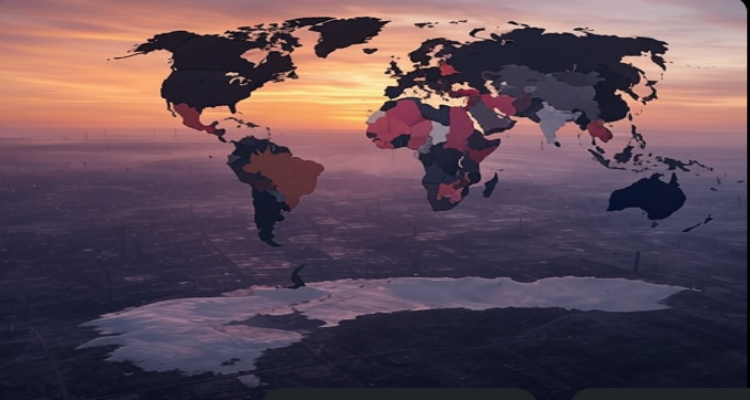Why Only Two Nations Might Survive a Global Catastrophe
Experts warn a nuclear war could kill five billion in 72 minutes. Discover why New Zealand and Australia might be the only survivors.
A Race Against the Clock: Humanity’s 72-Minute Warning
In a chilling scenario outlined by investigative journalist and Pulitzer Prize finalist Annie Jacobsen, the world as we know it could be irrevocably changed in just over an hour. In her recent appearance on The Diary of a CEO podcast, Jacobsen laid out a timeline that reads like a dystopian thriller—except it’s grounded in scientific fact. According to her, if nuclear war were to break out, five billion lives could be lost within just 72 minutes.
That’s not hyperbole. It’s physics.
“From the moment a nuclear missile is launched, the countdown begins,” said Jacobsen. “It takes 26 minutes and 40 seconds for a Russian ICBM to reach the East Coast of the United States—a figure that hasn’t changed since 1959.” Despite decades of technological evolution, the brutal efficiency of ballistic missiles remains the same.
The Six-Minute Dilemma: Presidential Power and the Black Book
What’s more frightening than nuclear war? The terrifyingly short decision-making window for retaliation. If a launch is detected, the President of the United States has just six minutes to decide on a response—using a top-secret manual known as the “Black Book.”
In that sliver of time, the leader of the free world must navigate a matrix of retaliatory options, all while facing the potential end of civilization. “This is the system we still use,” Jacobsen emphasized. “It’s a legacy of the Cold War, but it’s real and it’s active today.”
The Hidden Fallout: Global Climate Catastrophe and Famine
But the immediate explosions are only the beginning. The long-term aftermath could plunge the planet into a climate nightmare. According to atmospheric scientist Dr. Brian Toon, the smoke and soot from detonations would block sunlight, triggering a nuclear winter.
“Mid-latitude countries like Ukraine and Iowa could be buried in snow for a decade,” Jacobsen explained. Crops would fail globally, leading to famine on an unimaginable scale. “When agriculture fails, people just die,” she said bluntly.
And the dangers don’t stop at starvation. The ozone layer, already fragile, would suffer massive damage—leaving humans vulnerable to lethal ultraviolet rays. “People won’t be able to go outside. Survival would depend on living underground,” Jacobsen warned.
The Last Safe Havens: Why New Zealand and Australia Could Survive
Among the chaos, two countries stand out as possible sanctuaries: New Zealand and Australia. Their geographical remoteness, coupled with relatively stable climates, may allow them to maintain agricultural output even after global systems collapse.
“These nations are isolated enough to avoid the worst of the fallout,” Jacobsen noted. “And critically, they can still grow food—something that will be more valuable than gold.” Dr. Toon’s research supports this claim, pointing to the Southern Hemisphere’s resilience against the climatic consequences of nuclear conflict.
Modern Missiles, Ancient Deadlines
Despite advancements in AI, satellite tracking, and missile defense systems, Jacobsen says that the fundamental laws of physics still dominate nuclear timelines. “We haven’t changed gravity,” she said with stark finality. “Pyongyang’s missiles might take 33 minutes instead of 26, but we’re still talking about minutes—not hours, not days.”
This immutable reality makes nuclear preparedness more about timing than technology. “You can’t out-innovate physics,” she added.
A Stark Reminder from a Veteran Journalist
At 57, Anne Jacobsen brings a seasoned perspective to these global risks. Known for her bestselling exposé The Pentagon’s Brain, which uncovered the shadowy inner workings of DARPA, she now serves on a Columbia University committee advising on nuclear protocols and preparedness.
Her focus? Educating the public on the real and present dangers of nuclear conflict—not just as a geopolitical theory, but as a ticking time bomb built into our daily lives. “It’s not just a Cold War relic,” she told Politico. “It’s now.”
Conclusion: Preparing for the Unthinkable
The prospect of nuclear war is no longer confined to Cold War-era nightmares. As Jacobsen’s sobering analysis reveals, the clock would start ticking the moment a missile launches—and within a mere 72 minutes, civilization could unravel.
However, knowledge is power. By understanding the risks, recognizing the weak links in global defense systems, and advocating for updated protocols, we still have a chance to pull back from the brink. Because in a world where survival might hinge on geography and agriculture, foresight could mean everything.
Disclaimer:
This article is based on expert insights and current scientific analysis. It is intended to raise awareness and does not aim to incite fear or speculation. The views expressed are those of the experts cited and do not represent official government policy or predictions.











